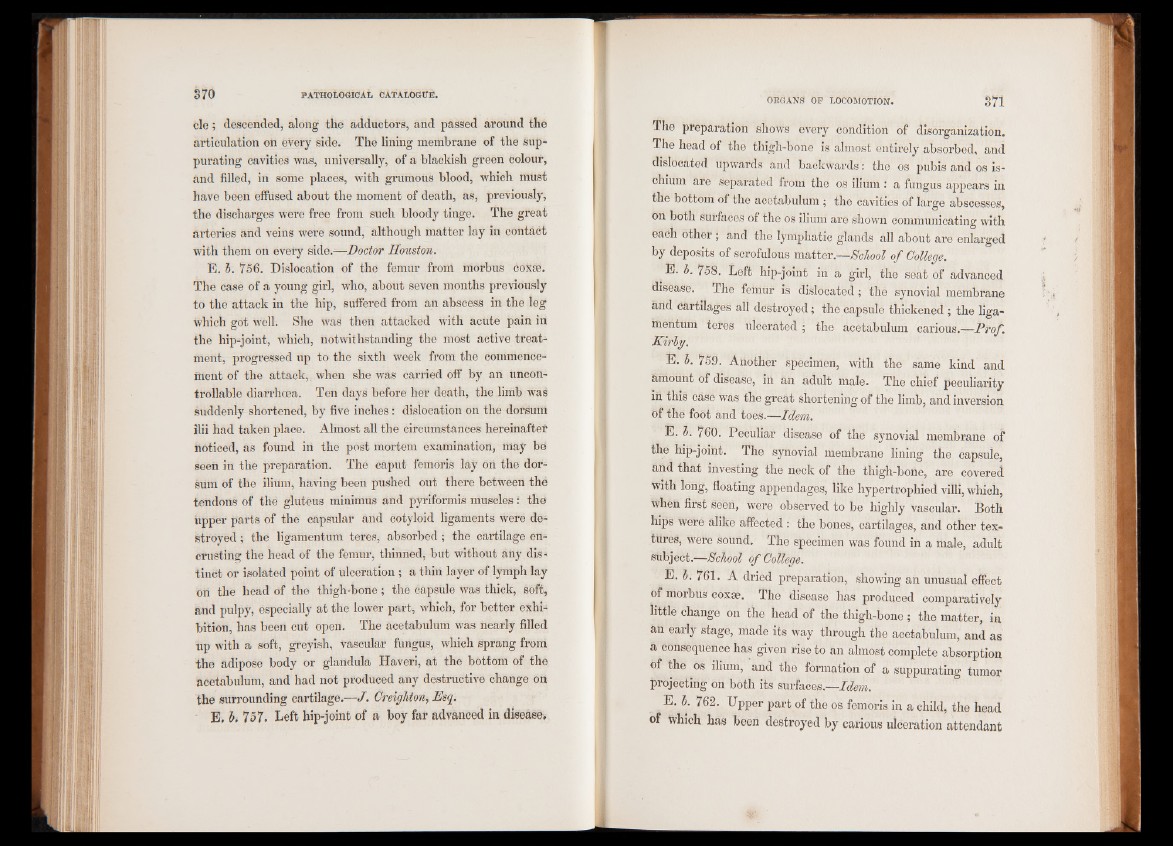
cle ; descended, along the adductors, and passed around the
articulation on every side. The lining membrane of the suppurating
cavities was, universally, of a blackish green colour,
and filled, in some places, with grumous blood, which must
have been effused about the moment of death, as, previously,
the discharges were free from such bloody tinge. The great
arteries and veins were sound, although matter lay in contact
with them on every side.—Doctor Houston.
E. b. 756. Dislocation of the femur from morbus coxae.
The case of a young girl, who, about seven months previously
to the attack in the hip, suffered from an abscess in the leg
which got well. She was then attacked with acute pain in
the hip-joint, which, notwithstanding the most active treatment,
progressed up to the sixth week from the commence-
inent of the attack,, when she was carried off by an uncontrollable
diarrhoea. Ten days before her death, the limb was
suddenly shortened, by five inches : dislocation on the dorSum
ilii had taken place. Almost all the circumstances hereinafter
noticed, as found in the post mortem examination, may be
seen in the preparation. The caput femoris lay on the dorsum
of the ilium, having been pushed out there between thé
tendons of the gluteus minimus and pyriformis muscles: the
upper parts of the capsular and cotyloid ligaments were destroyed
; the ligamentum teres, absorbed; the cartilage encrusting
the head of the femur, thinned, but without any distinct
or isolated point of ulceration ; a thin layer of lymph lay
on the head of the thigh-bone ; the capsule was thick, soft,
and pulpy, especially at the lower part, which, for better exhibition,
has been cut open. The acetabulum was nearly filled
up with a soft, greyish, vascular fungus, which sprang from
the adipose body or glandula Haveri, at the bottom of the
acetabulum, and had not produced any destructive change on
the surrounding cartilage.—J . Creighton> Esq.
E. 5. 757. Left hip-joint of a boy far advanced in disease.
The preparation shows every condition of disorganization.
The head of the thigh-bone is almost entirely absorbed, and
dislocated upwards and backwards: the os pubis and os ischium
are separated from the os ilium : a fungus appears in
the bottom of the acetabulum; the cavities of large abscesses,
on both surfaces of the os ilium are shown communicating with
eatih other; and the lymphatic glands all about are enlarged
by deposits of scrofulous matter.—School of College.
9. Wo. feffc hip-joint in a girl, the seat of advanced
disease. The feinur is dislocated; the synovial membrane
and Cartilages all destroyed; the capsule thickened; the liga-
inentum teres ulcerated ; the acetabulum carious.—Prof.
K irby.
E. b. 759. Another specimen, with the same kind and
amount of disease, in an adult male. The chief peculiarity
in this case was the great shortening of the limb, and inversion
of the foot and toes.—Idem.
E. b. 760. Peculiar disease of the synovial membrane of
the hip-joint. The synovial membrane lining the capsule,
and that investing the neck of the thigh-bone, are covered
with long, floating appendages, like hypertrophied villi, which,
when first Seen, were observed to be highly vascular. Both
hips Were alike affected : the bones, cartilages, and other textures,
were Sound. The specimen was found in a rtiale, adult
subject.—School of College.
E. b. 761. A dried preparation, showing an unusual effect
of morbus coxae. The disease has produced comparatively
little change on the head of the thigh-bone ; the matter, in
an early stage, made its way through the acetabulum, and as
a consequence has given rise to an almost complete absorption
of the os ilium, and the formation of a suppurating tumor
projecting on both its surfaces.—Idem.
E. b. 762. Upper part of the os femoris in a child, the head
of Which has been destroyed by carious ulceration attendant